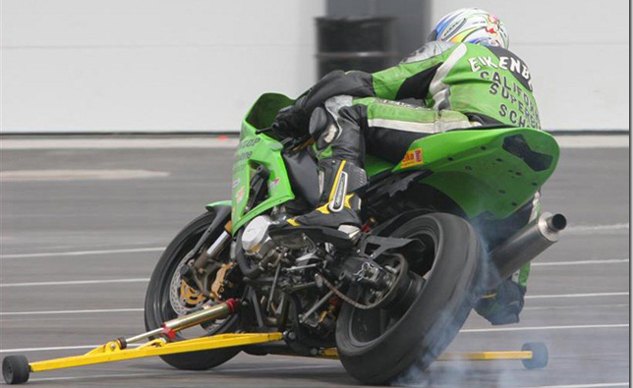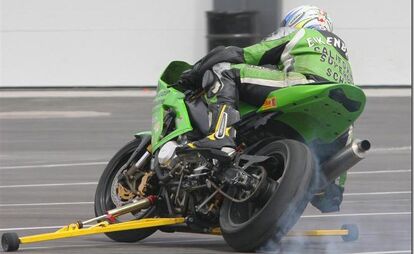Church Of MO – Custom Bike: California Superbike School's Lean/Slide Bike

Keith Code and his California Superbike School have taught a countless number of people how to ride a motorcycle to the best of their abilities. Sometimes, however, students can even learn what it’s like to ride beyond those abilities. The ever popular lean/slide bike is the device that will take you, relatively safely, beyond your limits. In this week’s Church of MO feature, Billy Bartels gets his hands on the lean/slide bike during a school he attended in 1998. Read on to see what it is, how it works, and why it applies to all riders, no matter what you ride.
Custom Bike: California Superbike School’s Lean/Slide Bike
By Billy Bartels Mar. 19, 1998
Photos by Patrick Rossiter
Even if you live in the flat American Midwest, you’ll eventually have to learn how negotiate a corner or two.
A few years ago Keith Code placed outriggers on a motorcycle to allow students to experience — without highsiding — how it feels when the front brake of a motorcycle is locked. Later, he discovered that many students questioned a motorcycle’s ability to lean. A new tool was needed, so Code created the Lean Bike.
Basically, the Lean Bike is a 1997 ZX-6R equipped with a set of outriggers that act like training wheels. The outriggers consist of a steel frame, hard rubber wheels and a pneumatically controlled lean damper system. To adjust the lean angle you push the horn button, which releases tension on the lean-damper. You can change the lean angle without releasing pressure, but it is difficult.
I rode the Lean/Slide Machine on a skid pad at the Streets of Willow Springs. First, an instructor hopped on the bike and repeatedly tried to highside. To date, no one has been able to flick it, but it is not immune to lowsides, so a bit of faith is involved. If you go too slowly, the bike can fall down. Also, while the bike itself is highside-proof, the rider is not. If you are not very careful, you can fly off the bike.
Right away I noticed that the bike doesn’t steer: It feels like it has a sidecar on both sides. However, once the horn button is pushed the tension on the outriggers is released and the bike may be leaned over. This is the biggest stumbling block for many students. Without the tension, they don’t believe that the outriggers will help keep the bike upright and they are afraid to lean the bike. However, those who overcome their mistrust will make huge improvements.
I was at a slight lean when I pushed the button. Next, the bike slammed all the way over to full lean. Once there, if you trust it, you can experiment with body positioning. This will upset a normal bike, but not the Lean Bike very much. After a few minutes of riding around in a big circle (and fighting dizziness), I was dragging knee.
The instructor explained that the trick is not to chop the throttle, which is a natural tendency, but to stay on the throttle and allow the bike to catch up. He also explained that on a set of race-compound tires even Keith Code, at least at skid-pad speeds, had a hard time getting the rear to break loose. I was only on a set of sorry looking Dunlop 204s but they still stuck better than I thought they would.
Eventually I produced a few controlled slides. This is not to say that learning how to control a rear-wheel slide is easy, but the Slide Bike is a good tool on which to learn. There are other ways to learn how to slide the rear wheel. For instance, flat track racing is an excellent way. Of course, there is also the good old-fashioned way: Trial and error on the street. However, flat track racing is very expensive and trial and error can be just as expensive (repair bills) and even more painful (medical bills). The Slide Bike is by far much less expensive and painful. If you’re like me, and you prefer to keep money in the bank and your body in one piece, I recommend the Slide Bike.
The Lean Bike is available to students at California Superbike School in any level. The Slide Bike is for Level Three students and above.

Troy's been riding motorcycles and writing about them since 2006, getting his start at Rider Magazine. From there, he moved to Sport Rider Magazine before finally landing at Motorcycle.com in 2011. A lifelong gearhead who didn't fully immerse himself in motorcycles until his teenage years, Troy's interests have always been in technology, performance, and going fast. Naturally, racing was the perfect avenue to combine all three. Troy has been racing nearly as long as he's been riding and has competed at the AMA national level. He's also won multiple club races throughout the country, culminating in a Utah Sport Bike Association championship in 2011. He has been invited as a guest instructor for the Yamaha Champions Riding School, and when he's not out riding, he's either wrenching on bikes or watching MotoGP.
More by Troy Siahaan









































Comments
Join the conversation
Sooo useful, just wish I had gotten more time on it when I did their school. It lets you get into the position of a full lean and feel how the bike reacts without the fear of lowsiding or going off.
Damn I would love a play on this for a weekend..